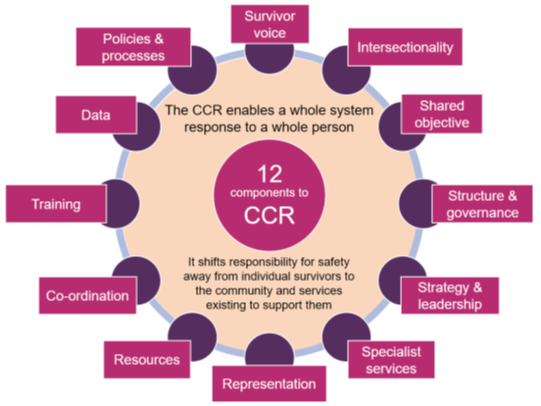Gudrun Burnet, CEO at Standing Together, shares insights into the nuances of a coordinated community response, and how this collaborative approach to ending domestic abuse is more important than ever in the wake of COVID-19.
Standing Together Against Domestic Abuse (STADA) is a national charity bringing communities together to end domestic abuse. We exist to keep survivors and their families safe, hold abusers to account, and end domestic abuse by transforming the way organisations and individuals think about, prevent, and respond to it. We do this through an approach that we pioneered, and for which we are known across the UK, called the Coordinated Community Response (CCR).
In November 2020 The MHCLG published the Social Housing White Paper . In April 2021 we will see the Royal Assent of the Domestic Abuse Bill and publication of the statutory guidance for Local Authorities to respond to domestic abuse. Covid-19 has seen an increase in domestic abuse nationally as victims/survivors have seen their help seeking routes restricted or obscured. Never has the coordinated community response to domestic abuse been more vital. Never have we relied so heavily on the community to be our eyes and ears to domestic abuse, to reach survivors and crucially help services identify and reach survivors when they can no longer reach out themselves for the help they need. Neighbours, family, colleagues, and friends have become the lifeline for so many. Research by the LSE after Lockdown#1 found that domestic abuse calls to the police increased by 11.4% on average compared with the same weeks in 2019. The increase was almost exclusively due to an increase in calls from third parties who are not directly witnessing the incident, and which include neighbours or family members.
As the excellent Women’s Aid Report “A Perfect Storm” tells us “Throughout the pandemic survivors have reported abuse worsening, and this has particularly been true for those living with their abuser”. We are aware that despite the restrictions that victims/survivors face in accessing support during the, now, 3 lockdowns, most services have seen increased demand. Many have seen the impact of the pandemic on access to other support services such as homelessness or mental health with housing & other offices where victim/survivors could once attend in person now available only virtually.
We know from our work in Domestic Abuse Housing Alliance (DAHA) that victims/survivors are reporting being unable to get through on the telephone so do not get the help when they need it. Housing providers are reporting that they saw a steady increase in disclosures and help seeking after the first lockdown in 2020 which has not slowed down at all. There is an increased pressure on providers to support families to stay safe in their own homes and to provide readily available move on accommodation as the pressure on refuge space continues to rise. We are delighted to see the response from the housing sector in this area – many have stepped up to support the domestic abuse sector where they can.
The Government encourages collaborative working with other agencies in the White Paper and the Bill. The CCR, the cornerstone of our work at Standing Together, is a collaborative multiagency effort to change the culture of tolerance of domestic abuse by embedding practices and procedures which integrates victim/survivor safety and holds the perpetrator to account for the abuse.
The CCR encompasses the broadest possible response to domestic abuse addressing prevention, early intervention, dealing with crisis, risk fluctuation, and long-term recovery and safety, working with a wide range of services, pathways, agencies, and systems. The fundamental premise of the CCR is that no single agency or individual can see the complete picture of the life of a family or individual within that family, but all may have insights and can provide interventions that are crucial to their safety and wellbeing. The CCR enables a whole system response to a whole person. It shifts responsibility for safety away from individual survivors to the community and services existing to support them.
Victims/survivors of domestic abuse – adult or child – require a coordinated, multiagency response with all agencies working collaboratively to provide a response that is effective in meeting their needs and making them safer. The model guides coordinators to build interventions within systems that are aligned with the lived experience of victims/survivors.
The CCR is made up of twelve components:

Each component is discussed in our nationally launched Guidance: In Search of Excellence 2020 (ISOE)©.
Behind these components is a set of core values and principles which agencies and partners need to share to make the CCR work which include collaboration, holding perpetrators to account and a shared understanding shared Leadership approach.
For the CCR to be effective, the responsibility for support and intervention must be spread across agencies, rather than held with a single agency or person. Standing Together believes that a combination of processes and people create the environment for development and improvement in ensuring effective support for victims of domestic abuse. A nominated lead who can hold the system together and committed CCR partners are essential. This report and guide describe how these pre-requisites and other components are desperately needed to change the culture around domestic abuse.
Victims/survivors and their experience provide the framework for designing and informing the work of the CCR. Interventions need to enhance and be linked to the work of the next agency processing the case and providing an intervention. The focus is never on the individual practitioner, it is on the policies, protocols and practices that inform the practitioners actions. Each intervention must balance prioritising victim/survivor safety and perpetrator accountability with improving the effectiveness and experience of the practitioner. Risk and contextual information must be collected, analysed, and shared at the very earliest opportunity, and outset of the case so that all agencies are making decisions based on consistent information to manage the perpetrator.
Practitioners work together with a strategic approach to resolve problems. The work to manage the perpetrator’s behaviour and increase the safety of the survivor/victim is daily business for all agencies working in collaboration with others. This may include working in small groups/meetings or one to one meetings/communication to share information and coordinate the most effective response.
The CCR provides communities with an approach to coordinating a response to domestic abuse. A process that places the needs of victims/survivors at the centre of that response. Advocates such as IDVAs and other specialist domestic abuse workers prioritise safety for victims/survivors. Advocates are linked most directly with the lived experience of victims of domestic abuse. Advocates are best positioned to engage victims/survivors into support and to provide the information to identify system gaps and gather feedback on service and intervention design and implementation which is essential to effectiveness.
Our ambition is that domestic abuse coordinators and / or leads, as well as all agencies and partners involved in delivering a CCR in their area, will use this guide to lead local partnerships in developing a more organised, integrated, and successful approach to the elimination of DA and VAWG more generally.
One of our CCR Ambassador Sites told us recently that having a good strong CCR in place meant that they could rapidly mobilise to provide an effective coordinated community response to domestic abuse through the first lockdown.
We know from our collective extensive experience of working in and with communities and partners that what may work in one area may not work as effectively in another, reflecting the nuance in local practices, challenges, and opportunities. A locally developed and owned response, rooted in the equal knowledge, experience, commitment and ideas of partners, is essential.

